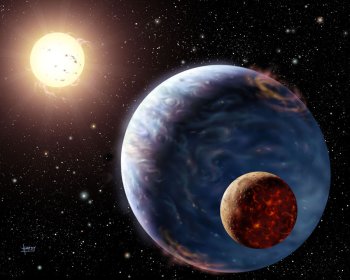Humans to extract billions of tons of precious metals from asteroids
Oceans of oil and thick layers of diamonds are hidden on remote exoplanets
So-called exoplanets, the planets that revolve around other stars, are supposed to contain large quantities of carbon, for they appeared as a result of coal dust and gas condensation. Their surface should therefore be somewhat soft and resinous, covering layers of Carborundum, or silicon. Such features are to be typical for at least Earth-sized planets. Thick layers of pure carbon should be embedded deeper under the surface of exoplanets. According to physical laws, highly-pressed carbon transforms in graphite and in diamonds. 
American physicians of Princeton and Carnegie Universities believe that rivers, seas and even oceans of such exoplanets should be filled with methane and oil, but not water.
Exoplanets are located at hundreds and thousands of light years far from Earth. Humans can only watch and observe such huge natural fields of diamonds and oil. A glut of wealth may also be situated a little closer to the Solar system. Another American physician, Katharina Lodders of Washington University, analyzed the information that had been obtained with the help of Huygens space probe, when it observed Jupiter and landed on its methane-clouded satellite, Titan.
It is generally believed that nucleuses of Solar system planets are made of iron, nickel and calcium. According to scientific theories, those chemical composites were condensed first from the gas-dust cloud that once surrounded the Sun. Lodders believes, however, that there was a 'tar-line' formed in the cloud of gas and dust - a ring around the Sun, in which carbon-rich material accumulated and condensed in something bigger, boulders, for instance.
Space boulders, which fall down on Earth from time to time, may contain graphite and even diamond particles, which indirectly proves the above-mentioned theory. It is not ruled out that the tar line could produce something bigger than just boulders – an Earth-sized planet, for example. It could be a planet with seas of oil and diamond beds underneath its surface.
There are a lot of worlds in the Galaxy, where the tar line is a lot wider. The planets in those worlds (if there are any planets there at all) were eventually formed in carbides, not stone. The largest number of such worlds has been observed next to the Galaxy's center, although the difference is still incomprehensible – not less than 1,000 light years.
Scientists believe that such planets could produce an unknown form of life, which considerably differs from terrestrial nature. Reasonable creatures of those planets might apparently be very peace-loving beings: it is impossible to strike a match in the world of methane and oil.
Diamond and oil planets are situated at distances, which human mind cannot even imagine. The matter thus poses a purely scientific interest. Humans can find and even obtain incredible wealth in space anyway, despite huge distances. Gold, diamond and platinum can be found on asteroids, which fly Earth by rather near. Asteroid Eros became a global sensation in 1999, when US space station NEAR successfully landed on the space rock and analyzed its structure. It turned that 2,900 cubic kilometers of space matter, from which Eros was made, contained 20 billion tons of aluminium, a similar amount of platinum, gold and other precious metals. In other words, there is a giant mine of rich resources flying somewhere near Earth. The reserves of the mine are evaluated at some 20-30 trillion dollars.
The present-day technological progress of human civilization does not allow to develop the space mine. However, such possibilities may appear in the future. Modern scientists already develop the sun-powered equipment and work on certain procedures to extract asteroid wealth.
Subscribe to Pravda.Ru Telegram channel, Facebook, RSS!




